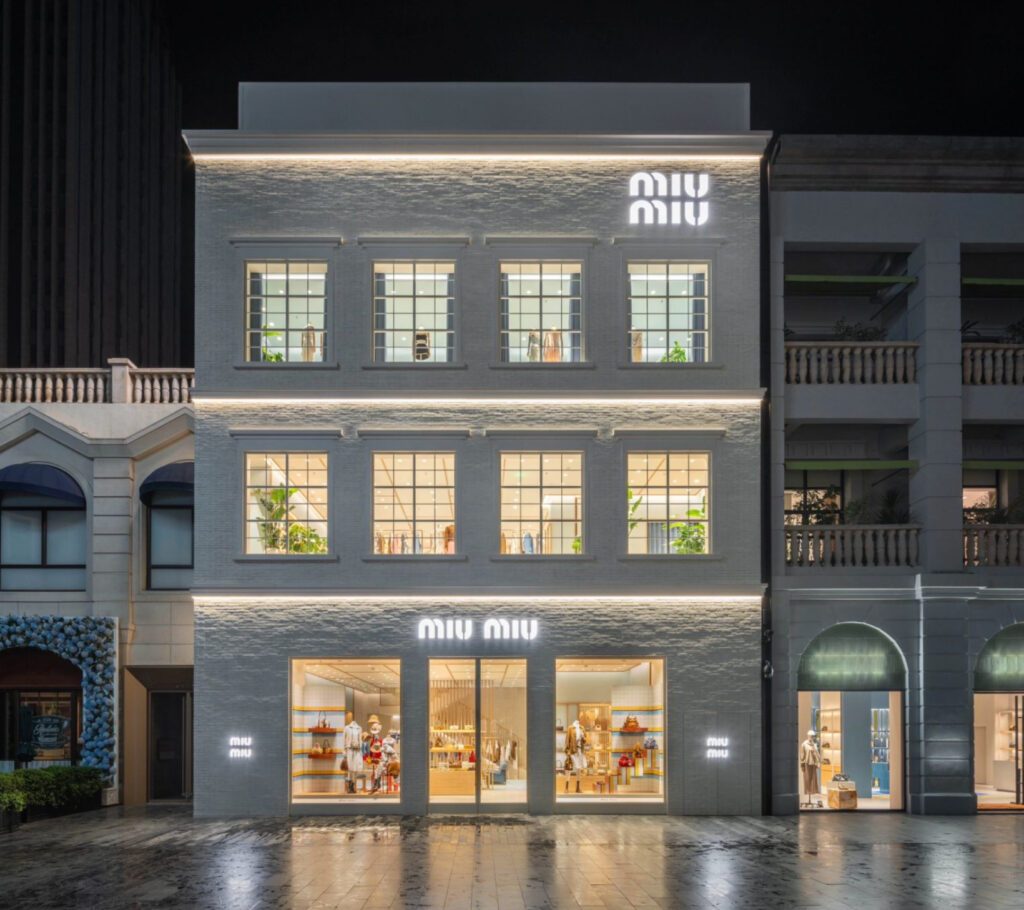
In an era where brick-and-mortar retail fights to remain relevant, Miu Miu isn’t just staying in the game—it’s redefining the rules. The brand’s new flagship boutique in Wuhan, recently unveiled at the prestigious Wuhan SKP mall, marks a significant milestone not only for the Prada-owned label but for bespoke retail as a whole. With immersive design, private salons, and curated experiences, the space stands as a physical translation of Miu Miu’s home aesthetics—intimate, intelligent, and unmistakably bold.
While many brands are downsizing or going digital-first, Miu Miu is doubling down on the power of place. This Wuhan flagship is not just a store. It’s a strategic experiment in how to blend architectural intimacy, exclusivity, and regional engagement into a high-performance retail machine.
And it’s working.
Wuhan: More Than a Location—A Statement
Wuhan might not have the instant international recognition of Beijing or Shanghai, but its selection is anything but random. Known as a cultural and economic hub in Central China, Wuhan is fast becoming a critical node in the luxury retail network. The city is home to a rising middle class, a fashion-aware youth, and a growing appetite for premium experience.
By opening in Wuhan SKP, especially within its newly dubbed “K Avenue” luxury corridor, Miu Miu signals a sophisticated regional play. The boutique positions the brand not just at the heart of a booming city—but at the front of a retail evolution that sees Tier 2 and Tier 3 cities not as peripheries, but as the next frontier of luxury.
This is not about reaching new customers. It’s about creating a context where those customers feel seen, valued, and immersed in the brand’s world.
Design as Strategy: Retail as Intimacy
The moment you step into Miu Miu’s Wuhan flagship, it’s clear this isn’t conventional retail. The store reads less like a commercial space and more like a private salon—a domestic fantasy translated into architecture. With soft lighting, plush textures, and curated art-like product displays, the boutique reflects what Miuccia Prada has always embedded in the Miu Miu ethos: femininity, subversion, and control.
The space is broken into immersive zones, with private salons offering VIP clients quiet seclusion for browsing, consultation, and styling. This layout does more than guide foot traffic—it creates mood. It invites exploration without overwhelming the senses. It fosters emotional intimacy in a commercial context.
In short, it’s less about consumption and more about connection.
Retail as Ecosystem: Personalization Over Presentation
Miu Miu’s Wuhan store isn’t just built for sales—it’s built for stories. Every corner, texture, and light fixture speaks to a carefully choreographed narrative: one of intimacy, exclusivity, and personalization.
In the modern luxury landscape, differentiation is currency. Every brand is trying to carve out space in a crowded market. What sets Miu Miu apart is how it focuses less on dominating the physical space and more on curating an emotional one.
This is a store designed not just to sell handbags but to make clients feel seen. Whether it’s one-on-one consultations, customized product drops, or private preview sessions, the focus is on building a brand relationship rather than pushing a product.
It’s an echo of a larger industry shift—one where experience outweighs exposure, and where connection beats conversion.
Beyond Tier 1: Luxury’s Deep Regional Shift
The Wuhan launch is emblematic of a growing movement: luxury brands going beyond Tier 1 cities in search of deeper regional engagement. Historically, cities like Beijing, Shanghai, and Shenzhen dominated brand footprints. But today, rising economic confidence and evolving consumer sophistication across China’s interior regions are reshaping the map.
Miu Miu’s choice of Wuhan speaks volumes. It reflects a brand that is not only globally relevant but locally aware. The K Avenue luxury corridor, modeled after similar concepts in Seoul and Tokyo, is designed to elevate retail into an experience. The corridor is architectural proof that even in smaller cities, luxury can—and must—be immersive.
Miu Miu isn’t just following foot traffic. It’s leading consumer psychology.
The Experience Economy, Now Physical
The phrase experience economy has been used for years, often tied to digital spaces, pop-ups, and virtual activations. But Miu Miu is flipping the script by investing in physical spaces that feel emotionally digital—not in format, but in feedback.
The Wuhan boutique, with its human-scale architecture and emphasis on storytelling, is the retail equivalent of a curated feed. Every room feels like a post-worthy moment, and every display is optimized not just for visibility but for intimate engagement.
This reflects Miu Miu’s broader strategy: using architecture to tell the story of the Miu Miu woman—curious, cultured, conscious. Not merely affluent, but aware.
Miu Miu Momentum: Beyond Stores, Into Culture
Miu Miu’s current momentum isn’t confined to physical retail. The brand’s collaboration with New Balance, especially the much-hyped 530 and 574 sneakers in distressed denim and pastel suede, speaks to a sharp instinct for cultural placement.
It’s not just about haute—it’s about cultural relevance.
By bridging the worlds of high fashion and streetwear, Miu Miu is reaching across generations. These kinds of unions help expand the brand’s vocabulary. Suddenly, it’s not just a label for runway regulars—it’s a cultural translator.
So when you walk into the Wuhan store, you’re not just stepping into a boutique—you’re stepping into a space that’s deeply plugged into what it means to wear culture.
The Numbers Don’t Lie: A Retail Rebound
Miu Miu’s design strategy and cultural fluency are paying off—literally.
In Q4, the brand posted an 84% increase in global retail sales, with APAC markets (including China) contributing an 11% jump. These are significant numbers in a year when many fashion houses are navigating volatility and contraction.
This growth underscores a few key truths:
- Experiential retail is alive and well.
- Tier 2 markets are essential to luxury’s future.
- Brands with strong cultural fluency win trust—and wallets.
Wuhan’s performance will likely serve as a test case for future expansions across similar cities like Chengdu, Hangzhou, and Xi’an.
Miu Miu’s new Wuhan flagship doesn’t just look good—it teaches. It offers a new rulebook for luxury retail:
- Design intimacy, not opulence.
Consumers crave space to feel, not just to buy. - Prioritize personalization.
One-size-fits-all retail is over. People want to be seen. - Make the store a story.
Every space should reflect brand values, not just display products. - Be locally fluent.
Understand the city. Speak its language. Respect its rhythms. - Invest in the physical.
Screens can’t replicate the emotional charge of a well-designed room.
The Hustle
Miu Miu’s Wuhan flagship is more than a store. It’s a prototype for fashion’s future—a space that rejects cold commercialism in favor of warmth, curation, and context. It proves that personal is the new premium, and that true luxury is about crafting environments where consumers don’t just shop—they feel.
By anchoring itself in Wuhan, and investing in physical space as emotional territory, Miu Miu sends a clear message: luxury isn’t about where you’re known. It’s about how deeply you’re felt.
And in this store, you feel it.
No comments yet.








